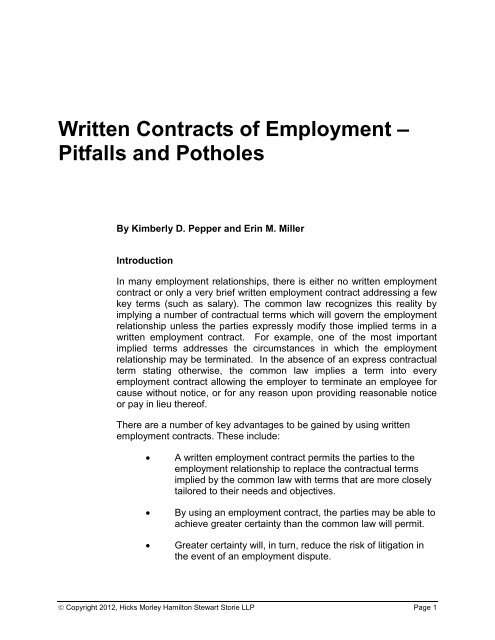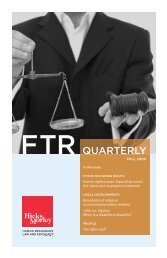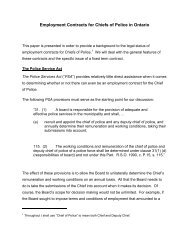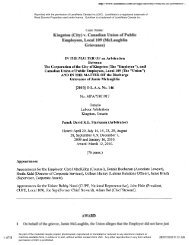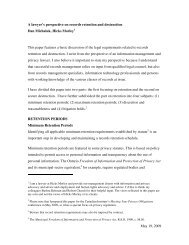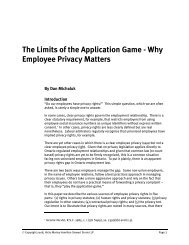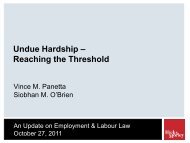Written Contracts of Employment - Pitfalls and Potholes - Hicks Morley
Written Contracts of Employment - Pitfalls and Potholes - Hicks Morley
Written Contracts of Employment - Pitfalls and Potholes - Hicks Morley
Create successful ePaper yourself
Turn your PDF publications into a flip-book with our unique Google optimized e-Paper software.
<strong>Written</strong> <strong>Contracts</strong> <strong>of</strong> <strong>Employment</strong> –<br />
<strong>Pitfalls</strong> <strong>and</strong> <strong>Potholes</strong><br />
By Kimberly D. Pepper <strong>and</strong> Erin M. Miller<br />
Introduction<br />
In many employment relationships, there is either no written employment<br />
contract or only a very brief written employment contract addressing a few<br />
key terms (such as salary). The common law recognizes this reality by<br />
implying a number <strong>of</strong> contractual terms which will govern the employment<br />
relationship unless the parties expressly modify those implied terms in a<br />
written employment contract. For example, one <strong>of</strong> the most important<br />
implied terms addresses the circumstances in which the employment<br />
relationship may be terminated. In the absence <strong>of</strong> an express contractual<br />
term stating otherwise, the common law implies a term into every<br />
employment contract allowing the employer to terminate an employee for<br />
cause without notice, or for any reason upon providing reasonable notice<br />
or pay in lieu there<strong>of</strong>.<br />
There are a number <strong>of</strong> key advantages to be gained by using written<br />
employment contracts. These include:<br />
• A written employment contract permits the parties to the<br />
employment relationship to replace the contractual terms<br />
implied by the common law with terms that are more closely<br />
tailored to their needs <strong>and</strong> objectives.<br />
• By using an employment contract, the parties may be able to<br />
achieve greater certainty than the common law will permit.<br />
• Greater certainty will, in turn, reduce the risk <strong>of</strong> litigation in<br />
the event <strong>of</strong> an employment dispute.<br />
© Copyright 2012, <strong>Hicks</strong> <strong>Morley</strong> Hamilton Stewart Storie LLP Page 1
To continue the example referred to above, there may be circumstances in<br />
which the parties will have a mutual interest in modifying the terms implied<br />
by the common law with respect to termination. The common law implied<br />
terms involve concepts that are highly elastic. One judge’s view <strong>of</strong> what<br />
constitutes “reasonable notice” can be very different from another’s – or,<br />
for that matter, from what the parties may have contemplated at the outset<br />
<strong>of</strong> the relationship. Indeed, the general trend in the case law appears to be<br />
towards longer notice periods. To customize the terms <strong>of</strong> the employment<br />
agreement to their particular relationship, increase certainty, manage<br />
potential liabilities, <strong>and</strong> decrease the risk <strong>of</strong> litigation, the parties may wish<br />
to negotiate specific provisions at the outset <strong>of</strong> their relationship which will<br />
govern in the event the relationship breaks down – such as provisions<br />
setting out the notice that will be provided if the contract is terminated<br />
without cause.<br />
However, the advantages <strong>of</strong> using written employment contracts can be<br />
easily lost if certain basic tenets are not followed. The following series <strong>of</strong><br />
questions <strong>and</strong> answers provides guidance with respect to these tenets.<br />
1. When should the contract be entered into<br />
The timing <strong>of</strong> the presentation <strong>and</strong> agreement to the terms <strong>of</strong> a written<br />
employment contract is a very important consideration when hiring<br />
employees. <strong>Written</strong> employment contracts should typically be provided to<br />
employees well in advance <strong>of</strong> when an employee is scheduled to start<br />
working for a new employer or in a new position that warrants a new<br />
contract. In recognition <strong>of</strong> the inevitable inequality <strong>of</strong> bargaining power<br />
between employers <strong>and</strong> employees, Canadian courts are inclined to<br />
question the enforceability <strong>of</strong> contracts <strong>and</strong> contractual terms where an<br />
employee has not had sufficient opportunity to consider the terms <strong>of</strong> the<br />
contract which he or she is being asked to sign.<br />
Employees should be permitted to have, at minimum, a few days to review<br />
<strong>and</strong> confirm their underst<strong>and</strong>ing <strong>of</strong> the terms <strong>of</strong> a new employment<br />
contract, <strong>and</strong> to permit them to seek independent legal advice on the<br />
terms laid out, if they so wish. By taking this approach, employers<br />
substantially reduce the potential for the employee to later assert that<br />
unfavourable contractual terms were not fully understood <strong>and</strong> agreed to,<br />
<strong>and</strong> therefore, should not be binding.<br />
Enforceability may also be compromised if the employment contract is<br />
ultimately executed following the commencement <strong>of</strong> employment. In<br />
© Copyright 2012, <strong>Hicks</strong> <strong>Morley</strong> Hamilton Stewart Storie LLP Page 2
Francis v. CIBC the Ontario Court <strong>of</strong> Appeal held that modification to a<br />
pre-existing contract will not be enforced unless the employer has<br />
provided “fresh consideration” to support the amended terms.<br />
Francis v. Canadian Imperial Bank <strong>of</strong> Commerce (1994), 7 C.C.E.L. (2d) 1<br />
(Ont. C.A.).<br />
In this case, at the time <strong>of</strong> his hire, Francis received a written <strong>of</strong>fer <strong>of</strong><br />
employment from CIBC that included the quantum <strong>of</strong> his salary <strong>and</strong><br />
outlined a start date. The letter stated that the <strong>of</strong>fer was contingent only<br />
upon a positive reference check. Francis, in writing, accepted the <strong>of</strong>fer on<br />
the terms <strong>and</strong> conditions outlined. However, when Francis reported for his<br />
first day <strong>of</strong> work, he was presented with a number <strong>of</strong> forms <strong>and</strong><br />
documents, including one identified as an “<strong>Employment</strong> Agreement.” The<br />
employment agreement contained a termination provision that limited the<br />
amount <strong>of</strong> notice to which he would be entitled in the event <strong>of</strong> a “without<br />
cause” termination.<br />
Although Francis signed the employment agreement, the Court <strong>of</strong> Appeal<br />
ultimately held that the agreement was not binding on him. Specifically,<br />
the Court found that all <strong>of</strong> the essential terms <strong>of</strong> Francis’ employment<br />
contract had been confirmed by CIBC <strong>and</strong> Francis in the initial <strong>of</strong>fer <strong>of</strong><br />
employment which Francis accepted prior to commencing employment.<br />
No new or additional consideration had been provided to Francis when he<br />
was presented with the variation <strong>of</strong> his original agreement with CIBC in the<br />
form <strong>of</strong> the “<strong>Employment</strong> Agreement”. As a result, the contract, including<br />
the clause limiting his right to reasonable notice, was found to be<br />
unenforceable.<br />
The Francis case is a clear reminder to employers to ensure that all <strong>of</strong> the<br />
essential terms <strong>of</strong> the employment contract are included in the<br />
employment <strong>of</strong>fer <strong>and</strong> agreed upon prior to the employee commencing<br />
employment. Alternatively, if such terms will be presented after<br />
employment commences, the employer must provide fresh consideration<br />
such as, for example, a signing bonus, to support the amended terms <strong>of</strong><br />
the agreement.<br />
© Copyright 2012, <strong>Hicks</strong> <strong>Morley</strong> Hamilton Stewart Storie LLP Page 3
2. Can the employer enforce a contractual notice provision which<br />
limits the employee’s notice/severance entitlement to the minimum<br />
amounts prescribed by applicable employment st<strong>and</strong>ards<br />
legislation<br />
An employer can limit an employee’s notice entitlement to the minimum<br />
statutory notice requirements under applicable employment st<strong>and</strong>ards<br />
legislation which has the effect <strong>of</strong> displacing an employee’s right under the<br />
common law to reasonable notice <strong>of</strong> termination. However, any<br />
employment contract clause seeking to have this effect must be drafted<br />
very carefully. As can be seen in Machtinger v. HOJ Industries Ltd., the<br />
courts are quick to void altogether any employment contract clause which<br />
violates an employee’s statutory entitlements.<br />
Machtinger v. HOJ Industries Ltd. (1992), 91 D.L.R. (4th) 491 (S.C.C.).<br />
Prior to commencing his employment, Machtinger signed a written<br />
employment contract containing a termination clause stating that his<br />
employment could be terminated at any time on a without cause basis with<br />
no notice or pay in lieu there<strong>of</strong>. Upon termination, however, the Company<br />
provided him with his minimum statutory entitlements under the<br />
<strong>Employment</strong> St<strong>and</strong>ards Act (the “ESA”).<br />
The Supreme Court <strong>of</strong> Canada held that due to the explicit language in the<br />
ESA which prohibits contracting out <strong>of</strong> legislative entitlements, <strong>and</strong> due to<br />
the fact that Machtinger’s termination provision did not meet the minimum<br />
ESA requirements, the contractual provision in question was clearly null<br />
<strong>and</strong> void.<br />
In addition to this finding, the Court also clarified that a contractual notice<br />
provision which fails to comply with minimum st<strong>and</strong>ards legislation will be<br />
null <strong>and</strong> void for all purposes, <strong>and</strong> cannot be used as an aid in determining<br />
the parties’ intent with respect to notice entitlements upon termination:<br />
In my view, an approach more consistent with the<br />
objects <strong>of</strong> the Act is that, if an employment contract fails<br />
to comply with the minimum statutory notice provisions<br />
<strong>of</strong> the Act, then the presumption <strong>of</strong> reasonable notice will<br />
not have been rebutted. Employers will have an<br />
incentive to comply with the Act to avoid the potentially<br />
longer notice periods required by the common law, <strong>and</strong><br />
in consequence more employees are likely to receive the<br />
benefit <strong>of</strong> the minimum notice requirements. Such an<br />
approach is also more consistent with the legislative<br />
© Copyright 2012, <strong>Hicks</strong> <strong>Morley</strong> Hamilton Stewart Storie LLP Page 4
intention expressed by s. 6 <strong>of</strong> the [ESA], which expressly<br />
preserves the civil remedies otherwise available to an<br />
employee against his or her employer.<br />
Therefore, where a contractual notice provision that does not meet the<br />
ESA minimum st<strong>and</strong>ards is voided, the Court will not conclude that the<br />
parties intended to limit the employee’s notice entitlement to the minimum<br />
statutory requirements; rather, the employee will be entitled to reasonable<br />
notice <strong>of</strong> termination in accordance with common law principles.<br />
3. How can the employer ensure that a notice provision which<br />
limits the employee’s entitlement to the minimum statutory<br />
requirements is enforceable<br />
Provided the termination provision is clear <strong>and</strong> the employee has been<br />
given the opportunity to review the contract prior to signing it, a contractual<br />
provision which restricts the employee’s notice entitlement to statutory<br />
notice should be enforced irrespective <strong>of</strong> whether the employee would be<br />
entitled to greater notice at common law.<br />
Mesgarlou v. 3XS Enterprises (2002) Unreported O.J. No. 4323 (Ont.<br />
S.C.).<br />
In Mesgarlou, the employee executed an employment agreement<br />
containing a termination provision as follows:<br />
After the first three (3) months <strong>of</strong> employment, both<br />
parties shall give notice in accordance with the Ontario<br />
<strong>Employment</strong> St<strong>and</strong>ards Act prior to terminating this<br />
employment agreement.<br />
The Plaintiff was terminated <strong>and</strong> the issue was whether his notice<br />
entitlement was restricted to his minimum statutory entitlements under the<br />
ESA. The Court held that the notice provision was, in fact, sufficiently<br />
clear <strong>and</strong> unambiguous as to rebut the common law presumption that<br />
reasonable notice was required in order to terminate Mesgarlou’s<br />
employment. The Court held:<br />
Granted, the plaintiff didn’t seem to pay much attention<br />
to the termination clause in the contract but that was his<br />
choice. He had lots <strong>of</strong> opportunity to look into it <strong>and</strong> to<br />
seek advice [prior to signing the agreement]. He has<br />
obviously sought pr<strong>of</strong>essional advice in relation to his<br />
income tax affairs <strong>and</strong> is, from his testimony before me,<br />
a competent <strong>and</strong> sophisticated businessman, well used<br />
© Copyright 2012, <strong>Hicks</strong> <strong>Morley</strong> Hamilton Stewart Storie LLP Page 5
to looking our for his interests. Nor can it be said that he<br />
was in a vulnerable bargaining position in relation to the<br />
defendant. He showed that by negotiating such<br />
significant increases in his production bonuses. In my<br />
view, the plaintiff was simply not particularly concerned<br />
about termination <strong>and</strong> period <strong>of</strong> notice.<br />
It should be noted that although the Court held that the contractual notice<br />
provision was enforceable, in our respectful view, the clause in question<br />
left open the possibility that additional common law notice would be<br />
payable. The clause did not state that the employee would only be<br />
entitled to his notice under the ESA; it stated that he would be given<br />
notice in accordance with the ESA. In our opinion, where an employer<br />
seeks to limit an employee’s notice entitlement to the statutory<br />
requirements, it is prudent to ensure that the notice provision expressly<br />
states that the employee will only receive his/her minimum statutory<br />
entitlements under applicable employment st<strong>and</strong>ards legislation <strong>and</strong> that<br />
that such payments are in full satisfaction <strong>of</strong> any <strong>and</strong> all notice<br />
entitlements.<br />
4. What happens if the notice provision initially accords with<br />
statutory requirements but might eventually violate the ESA once the<br />
employee accumulates a certain amount <strong>of</strong> service<br />
Not only will a contractual notice provision be voided where, from the<br />
outset <strong>of</strong> the contract, the notice provision fails to comply with minimum<br />
statutory requirements, a provision will also be void if the provision may, at<br />
some future date, violate the statutory minimums.<br />
Wright v. The Young <strong>and</strong> Rubicam Group <strong>of</strong> Companies (Wunderman)<br />
2011 ONSC 4720.<br />
The Plaintiff (Wright), an executive vice president, signed an employment<br />
contract containing a “without cause” termination provision which<br />
prescribed the amount <strong>of</strong> notice that he would be entitled to in the event <strong>of</strong><br />
a “without cause” termination. Wright was terminated with just over five<br />
years’ service, <strong>and</strong> was provided with 13 weeks pay in lieu <strong>of</strong> notice <strong>and</strong><br />
other benefits. This amount complied with the applicable ESA<br />
requirements.<br />
However, at trial, Wright argued that the contractual notice provision did<br />
not comply with the ESA <strong>and</strong> should be declared void as a result. He<br />
argued that once he had completed a certain number <strong>of</strong> years’ service, the<br />
© Copyright 2012, <strong>Hicks</strong> <strong>Morley</strong> Hamilton Stewart Storie LLP Page 6
contractual notice provision would no longer comply with the minimum<br />
statutory requirements. The Court agreed with Wright’s reasoning on this<br />
point, <strong>and</strong> declared the contract to be void as a result even though at the<br />
date <strong>of</strong> termination, the contractual notice provision complied with the<br />
applicable ESA requirements. In the result, the Court held that Wright was<br />
not limited to the 13 weeks’ notice which was paid to him; rather, he was<br />
entitled to 12 months common law notice.<br />
The lesson to be taken from Wright is that contractual notice provisions<br />
must be carefully drafted to ensure that, as the employee acquires more<br />
service, the notice prescribed by the contract will always comply with<br />
minimum statutory requirements.<br />
5. Is the contractual notice subject to mitigation<br />
A very recent decision <strong>of</strong> the Ontario Court <strong>of</strong> Appeal has held that an<br />
employment contract which fixes the period <strong>of</strong> notice upon termination<br />
without cause, but makes no specific reference to mitigation, does not<br />
attract the obligation to mitigate that typically attaches to the common law<br />
notice.<br />
Bowes v. Goss Power Products Ltd., 2012 ONCA 425.<br />
In this case, the Plaintiff was dismissed without cause <strong>and</strong> was provided<br />
with six months notice pursuant to the fixed notice period set out in his<br />
employment agreement. Two weeks later, he obtained a position with<br />
another employer at the same salary. Goss Power took the position that,<br />
as a result <strong>of</strong> securing alternate employment, the Plaintiff had mitigated<br />
his damages <strong>and</strong> accordingly, paid out only three weeks notice in<br />
accordance with the minimum statutory notice requirements.<br />
The application judge dismissed the Plaintiff’s argument that this was a<br />
breach <strong>of</strong> the employment contract, <strong>and</strong> found that the duty to mitigate<br />
applied even where there was a fixed termination notice period in the<br />
employment contract. In overturning this decision, the Court <strong>of</strong> Appeal<br />
found that the application judge had mischaracterized a fixed notice<br />
period as analogous to damages in lieu <strong>of</strong> reasonable notice at common<br />
law. In doing so, the application judge had wrongly concluded that there<br />
was a presumption that the Plaintiff had a duty to mitigate, <strong>and</strong> that the<br />
agreement’s silence on this point indicated that the presumption had not<br />
been rebutted, <strong>and</strong> that mitigation should be applicable to the calculation<br />
<strong>of</strong> damages.<br />
© Copyright 2012, <strong>Hicks</strong> <strong>Morley</strong> Hamilton Stewart Storie LLP Page 7
Instead, the Court <strong>of</strong> Appeal found that where an employment agreement<br />
contains a stipulated entitlement on termination without cause <strong>and</strong> is silent<br />
as to the obligation to mitigate, the employee will not be required to<br />
mitigate. This conclusion was based on the following:<br />
• in contracting for a fixed sum, the parties had contracted out<br />
<strong>of</strong> the common law concept <strong>of</strong> reasonable notice or<br />
damages in lieu there<strong>of</strong>;<br />
• by specifying a set amount, the stipulated amount is<br />
characterized as either liquidated damages or a contractual<br />
sum, <strong>and</strong> mitigation is not a live issue in these<br />
circumstances;<br />
• the inherent unfairness in permitting the employer to rely on<br />
the certainty <strong>of</strong> fixed damages <strong>and</strong> then permitting the<br />
employer to seek a lower sum by raising the issue <strong>of</strong><br />
mitigation not previously mentioned; <strong>and</strong><br />
• the inconsistency <strong>and</strong> counter-intuitiveness in permitting the<br />
parties to contract for certainty, while leaving mitigation as a<br />
live issue with a significant risk for litigation.<br />
The Court’s reasoning was further confirmed in this case by the presence<br />
<strong>of</strong> a broad release in the applicable employment agreement, indicating an<br />
intention to avoid litigation, confirming a desire for finality <strong>and</strong> bolstering<br />
the finding that the parties did not intend for mitigation to be required<br />
unless expressly set out.<br />
Significantly, the Court also clarified, from a practical perspective, that<br />
where parties intend that mitigation is to apply in cases where an<br />
agreement specifies a fixed amount <strong>of</strong> notice, they must express this<br />
intention in clear <strong>and</strong> specific contractual language.<br />
© Copyright 2012, <strong>Hicks</strong> <strong>Morley</strong> Hamilton Stewart Storie LLP Page 8
6. Restrictive Covenants – Are they enforceable<br />
Employers <strong>of</strong>ten use employment contracts to assist in protecting<br />
confidential business information <strong>and</strong> proprietary interests. To this end,<br />
employers include in the employment agreement or as a st<strong>and</strong>-alone<br />
agreement, non-competition, non-solicitation <strong>and</strong>/or confidentiality<br />
agreements which place certain restrictions on the employee’s activities<br />
after the employment relationship ceases. In appropriate circumstances,<br />
these covenants are enforceable, but great care must be taken in both<br />
drafting <strong>and</strong> selecting such clauses.<br />
In particular, employers must carefully weigh their interests which require<br />
protection against the restrictions which are sought to be imposed through<br />
the contractual provision. Proportionality <strong>and</strong> reasonableness are central<br />
to the enforceability <strong>of</strong> these contractual terms, as courts will refuse to<br />
enforce any overly broad restraint on an individual’s ability to work <strong>and</strong><br />
compete.<br />
H.L. Staebler Company Limited v. Allan, 2008 ONCA 576.<br />
In this case, the Ontario Court <strong>of</strong> Appeal considered the enforceability <strong>of</strong><br />
restrictive covenants where two employees resigned <strong>and</strong> immediately<br />
began working in a similar capacity for another employer in the insurance<br />
industry. Both employees were subject to restrictive covenants on their<br />
post-employment activities for a two year period following the termination<br />
<strong>of</strong> their employment.<br />
The Court highlighted the framework for determining whether a restrictive<br />
covenant is reasonable <strong>and</strong> therefore enforceable:<br />
The starting point is “an overall assessment <strong>of</strong> the clause, the<br />
agreement within which it is found, <strong>and</strong> all <strong>of</strong> the surrounding<br />
circumstances.” Thereafter, three factors must be considered.<br />
First, did the employer have a proprietary interest entitled to<br />
protection Second, are the temporal or spatial features <strong>of</strong> the<br />
covenant too broad And, third, is the covenant unenforceable as<br />
being against competition generally, <strong>and</strong> not limited to proscribing<br />
solicitation <strong>of</strong> clients <strong>of</strong> the former employer<br />
In concluding that the restrictive covenant in this case was not<br />
enforceable, the Court not only utilized the above analysis, but also<br />
© Copyright 2012, <strong>Hicks</strong> <strong>Morley</strong> Hamilton Stewart Storie LLP Page 9
emphasized the importance <strong>of</strong> selecting the appropriate clause in seeking<br />
to protect an employer’s interests.<br />
The Court held that an appropriately drafted non-solicitation clause may<br />
<strong>of</strong>ten be sufficient to protect an employer without unduly restraining an<br />
employee’s ability to work. A non-competition clause, which restrains<br />
employees from conducting business with former clients <strong>and</strong> customers,<br />
was found by the Court to only be enforceable in exceptional<br />
circumstances. In Staebler, the Court ultimately found that the restrictive<br />
covenant in question was, in fact, a blanket non-competition clause, <strong>and</strong><br />
thus was unenforceable.<br />
Mason v. Chem-Trend Limited Partnership, 2011 ONCA 322.<br />
This case aptly demonstrates the practical application <strong>of</strong> the framework<br />
outlined in Staebler. At issue here was a restrictive covenant providing<br />
that for one year following any termination for any reason, the terminated<br />
employee would not:<br />
[…] directly or indirectly, for my own account or as an employee or agent<br />
<strong>of</strong> any business entity, engage in any business or activity in competition<br />
with the Company by providing services or products to, or soliciting<br />
business from, any business entity which was a customer <strong>of</strong> the<br />
Company during the period in which I was an employee <strong>of</strong> the Company,<br />
or take any action that will cause the termination <strong>of</strong> the business<br />
relationship between the Company <strong>and</strong> any customer, or solicit for<br />
employment any person employed by the Company.<br />
In determining whether the clause was enforceable, the application judge<br />
accepted that because <strong>of</strong> the world-wide nature <strong>of</strong> the respondent’s<br />
operations <strong>and</strong> many <strong>of</strong> its customers, it was reasonable that the covenant<br />
be broad <strong>and</strong> geographically world-wide. Second, the Court held that it<br />
was reasonable to restrict any activity <strong>of</strong> the appellant which was in<br />
competition with the respondent because <strong>of</strong> the appellant’s access to<br />
significant information about the respondent’s business <strong>and</strong> his technical<br />
knowledge <strong>of</strong> the industry. Finally, the Court found that the one-year<br />
temporal restriction was relatively short compared to other cases. The<br />
Court concluded that the more onerous geographic <strong>and</strong> activity restrictions<br />
in this covenant were balanced out by the shorter temporal limitation,<br />
making the clause as a whole a reasonable one.<br />
© Copyright 2012, <strong>Hicks</strong> <strong>Morley</strong> Hamilton Stewart Storie LLP Page 10
The Ontario Court <strong>of</strong> Appeal ultimately disagreed with this analysis, based<br />
upon the following findings:<br />
(a)<br />
(b)<br />
(c)<br />
(d)<br />
the existence <strong>of</strong> other protections (i.e. contractual clauses)<br />
that provided the respondent with significant protection;<br />
the fact that the prohibition on dealing with businesses which<br />
may be former customers <strong>of</strong> the company was not consistent<br />
with a one year restriction on competition, which would then<br />
allow the employee to compete freely;<br />
the nature <strong>of</strong> the employment, as the appellant was part <strong>of</strong><br />
the technical sales force for a large company, operating in a<br />
limited sales territory; <strong>and</strong><br />
the fact that the clause was unworkable because in practice<br />
it was not possible for the appellant to know which potential<br />
customers he was prohibited from doing business with, given<br />
that the appellant had no way to know whether any particular<br />
potential contact was, or had been at some point over his<br />
extensive employment, a customer <strong>of</strong> the company’s global<br />
operations.<br />
As a result, the Court ultimately allowed the appeal <strong>and</strong> granted a<br />
declaration that the restrictive covenant was unreasonable <strong>and</strong> therefore,<br />
unenforceable by the respondent.<br />
The Staebler <strong>and</strong> Mason cases signal the need to use extreme care in<br />
deciding whether to insist upon some form <strong>of</strong> restrictive covenant in an<br />
employment agreement <strong>and</strong>, where such a covenant is deemed<br />
necessary, in drafting the provision to ensure that the clause is not<br />
overreaching in scope.<br />
© Copyright 2012, <strong>Hicks</strong> <strong>Morley</strong> Hamilton Stewart Storie LLP Page 11


